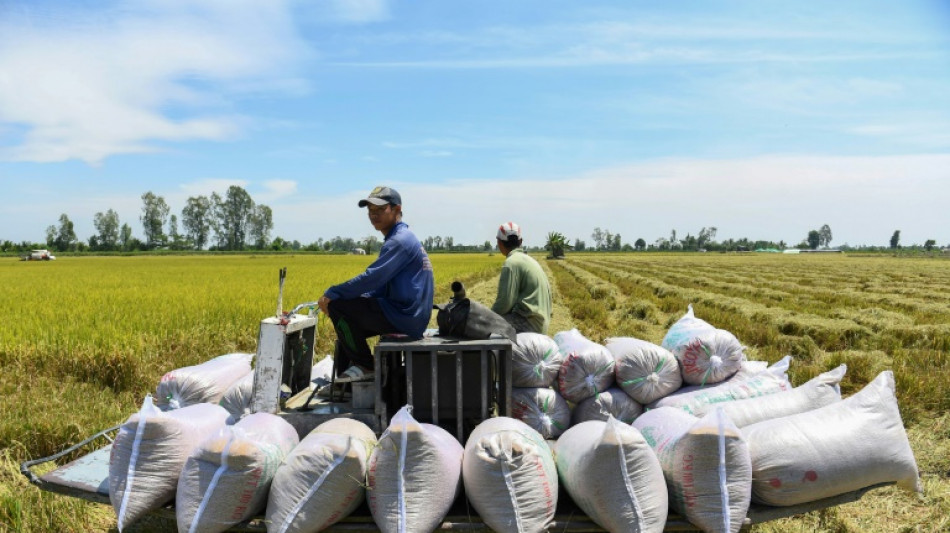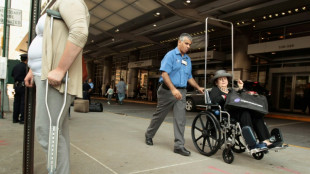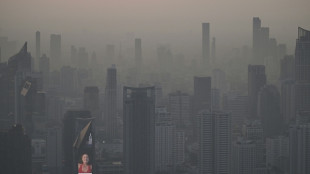
-
 Queen Camilla recalls fighting back against train attacker
Queen Camilla recalls fighting back against train attacker
-
Stocks drop at end of record year for markets

-
 Amorim still 'really confident' about Man Utd potential despite Wolves draw
Amorim still 'really confident' about Man Utd potential despite Wolves draw
-
Berlin says decision postponed on European fighter jet

-
 Iran prosecutor pledges 'decisive' response if protests destabilise country
Iran prosecutor pledges 'decisive' response if protests destabilise country
-
Emery defends failure to shake hands with Arteta after Villa loss to Arsenal

-
 China says to impose extra 55% tariffs on some beef imports
China says to impose extra 55% tariffs on some beef imports
-
Japanese women MPs want more seats, the porcelain kind

-
 Guinea junta chief Doumbouya elected president: election commission
Guinea junta chief Doumbouya elected president: election commission
-
Pistons pound Lakers as James marks 41st birthday with loss

-
 Taiwan coastguard says Chinese ships 'withdrawing' after drills
Taiwan coastguard says Chinese ships 'withdrawing' after drills
-
France's homeless wrap up to survive at freezing year's end

-
 Leftist Mamdani to take over as New York mayor under Trump shadow
Leftist Mamdani to take over as New York mayor under Trump shadow
-
French duo stripped of Sydney-Hobart race overall win

-
 Thailand releases 18 Cambodian soldiers held since July
Thailand releases 18 Cambodian soldiers held since July
-
Tiny tech, big AI power: what are 2-nanometre chips?

-
 Libyans savour shared heritage at reopened national museum
Libyans savour shared heritage at reopened national museum
-
Asia markets mixed in final day of 2025 trading

-
 Global 'fragmentation' fuelling world's crises: UN refugee chief
Global 'fragmentation' fuelling world's crises: UN refugee chief
-
Difficult dance: Cambodian tradition under threat

-
 Regional temperature records broken across the world in 2025
Regional temperature records broken across the world in 2025
-
'Sincaraz' set to dominate as 2026 tennis season kicks off

-
 Bulgaria readies to adopt the euro, nearly 20 years after joining EU
Bulgaria readies to adopt the euro, nearly 20 years after joining EU
-
Trump v 'Obamacare': US health costs set to soar for millions in 2026

-
 Isiah Whitlock Jr., 'The Wire' actor, dies at 71
Isiah Whitlock Jr., 'The Wire' actor, dies at 71
-
SoftBank lifts OpenAI stake to 11% with $41bln investment

-
 Bangladesh mourns ex-PM Khaleda Zia with state funeral
Bangladesh mourns ex-PM Khaleda Zia with state funeral
-
TSMC says started mass production of 'most advanced' 2nm chips

-
 Australian cricket great Damien Martyn 'in induced coma'
Australian cricket great Damien Martyn 'in induced coma'
-
Guinea junta chief Doumboya elected president: election commission

-
 Apex Provides Recap of 2025 Regional Exploration Drilling and Priority Follow Up Targets at the Cap Critical Minerals Project
Apex Provides Recap of 2025 Regional Exploration Drilling and Priority Follow Up Targets at the Cap Critical Minerals Project
-
Guardian Metal Resources PLC Announces Total Voting Rights

-
 Caballero defends Maresca after Palmer substitution sparks jeers
Caballero defends Maresca after Palmer substitution sparks jeers
-
Depleted Man Utd 'lack quality', says Amorim

-
 'We know what we want': Arteta eyes title after Arsenal thrash Villa
'We know what we want': Arteta eyes title after Arsenal thrash Villa
-
Arsenal crush Villa to make statement in title race

-
 Senegal top AFCON group ahead of DR Congo as Tanzania make history
Senegal top AFCON group ahead of DR Congo as Tanzania make history
-
Maresca in the firing line as Chelsea stumble against Bournemouth

-
 Senegal top AFCON group, DR Congo to face Algeria in last 16
Senegal top AFCON group, DR Congo to face Algeria in last 16
-
Norway's Magnus Carlsen wins 20th world chess title

-
 Patriots star Diggs facing assault charges: reports
Patriots star Diggs facing assault charges: reports
-
Journalist Tatiana Schlossberg, granddaughter of JFK, dies at 35

-
 Rio receives Guinness record for biggest New Year's bash
Rio receives Guinness record for biggest New Year's bash
-
Jokic out for four weeks after knee injury: Nuggets

-
 World bids farewell to 2025, a year of Trump, truces and turmoil
World bids farewell to 2025, a year of Trump, truces and turmoil
-
Far-right leader Le Pen to attend Brigitte Bardot's funeral

-
 Drones dive into aviation's deepest enigma as MH370 hunt restarts
Drones dive into aviation's deepest enigma as MH370 hunt restarts
-
German dog owners sit out New Year's Eve chaos in airport hotels

-
 Tanzania hold Tunisia to end 45-year wait for AFCON knockout spot
Tanzania hold Tunisia to end 45-year wait for AFCON knockout spot
-
10 countries warn of 'catastrophic' Gaza situation


The other greenhouse gases warming the planet
While carbon dioxide, or CO2, is the best known greenhouse gas, several others, including methane and nitrous oxide, are also driving global warming and altering the Earth's climate.
Atmospheric concentrations of all three hit new highs in 2023, locking in future temperature increases for years to come, the World Meteorological Organization reported in October.
- Methane -
CO2 accounts for about two-thirds of the warming attributed to greenhouse gases, said Piers Forster, an expert at the University of Leeds and author of reports by the IPCC, the UN's climate science panel.
Methane, or CH4, is the second most important greenhouse gas linked to human activity after CO2.
Around 40 percent of methane comes from natural sources, notably wetlands, but the majority (around 60 percent) is linked to human activities such as agriculture (ruminant breeding and rice cultivation), fossil fuels and waste.
Its warming power is more than 80 times greater over 20 years than that of CO2, but its lifespan is shorter, making it an important lever in attempts to limit global warming in the short term.
Reducing methane emissions "would have a strong short-term cooling effect, because atmospheric methane concentrations would drop quickly", said Mathijs Harmsen, a researcher at the PBL Netherlands Environmental Assessment Agency.
Policies should "focus on capturing the low hanging fruit, so the very low-cost measures such as reducing natural gas leaks", he said.
Despite a global commitment to reduce planet-heating emissions signed by many countries, including the European Union and the United States, the trend is not positive.
"Methane is rising faster in relative terms than any major greenhouse gas and is now 2.6-fold higher than in pre-industrial times," said an international group of researchers under the aegis of the Global Carbon Project, in a study published in the academic journal Environmental Research Letters.
- Nitrous oxide -
Nitrous oxide, or nitrous protoxide (N2O), is the third major greenhouse gas and almost 300 times more potent than CO2.
It is mainly emitted by synthetic nitrogen fertilisers and manure used in agriculture.
Other emissions come from human activities (the chemical industry, wastewater, fossil fuels) or natural sources (the soil and oceans).
"Global human-induced emissions, which are dominated by nitrogen additions to croplands, increased by 30 percent over the past four decades," concluded a major study in the journal Nature in 2020.
The key to the problem lies in more efficient use of fertilisers.
"Two-thirds of the climate change mitigation potential of N2O could be realised by reducing fertilisers on just 20 percent of the world's cropland, particularly in humid subtropical agricultural regions," wrote French researcher Philippe Ciais in 2021.
- Fluorinated gases -
Fluorinated greenhouse gases (PFCs, HFCs and SF6) are found in fridges, freezers, heat pumps, air conditioners and electrical networks.
Even when in small quantities, they stand out for their extremely high warming capacity.
For example, SF6, which is found in electrical transformers, has a greenhouse effect 24,000 times greater than CO2 over a 100-year period.
The Montreal Protocol signed in 1987, and ratified by 195 countries, has already significantly reduced the atmospheric presence of CFCs, another ozone-depleting fluorinated gas.
In 2016 the Kigali agreement also provided for the phasing out of HFCs.
And last year the EU sealed a pact to progressively ban the sale of equipment containing fluorinated gases, in particular HFCs, with the aim of eliminating them completely by 2050.
F.Pedersen--AMWN


